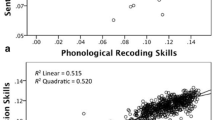Abstract
Forty adults who had been diagnosed as reading disabled when they were children and 40 adults from a matched control group of normal readers were tested to assess the diagnostic utility of a newly developed set of tests as well at to ascertain whether or not reading disability persists into early adulthood. The new measures, designed to examine cognitive processing rates in disabled and normal adult readers, included expressive verbal fluency, confrontation naming, and perceptual speed. Evidence for significantly slower cognitive processing rates and persistent problems in reading and spelling was apparent among the young adult disabled readers. Spatial and mathematical ability levels were well within the normal range.
Similar content being viewed by others
References
Baker L. M., Decker S. N. and DeFries J. C. 1984. Cognitive abilities in reading-disabled children: A longitudinal study. Journal of Child Psychology and Psychiatry, 25, 111–117.
Decker S. N. and DeFries J. C. 1980. Cognitive abilities in families of reading-disabled children. Journal of Learning Disabilities, 13, 517–522.
Decker S. N. and DeFries J. C. 1981. Cognitive ability profiles in families of reading-disabled children. Developmental Medicine and Child Neurology, 23, 217–227.
Denckla M. B. and Rudel R. G. 1976. Rapid ‘automatized” naming: Dyslexia differentiated from other learning disabilities. Neuropsychologia, 14, 471–479.
Dunn L. N. and Markwardt F. S. 1970. Examiner's manual: Peabody Individual Achievement Test. Circle Pines, MN: American Guidance Service.
Gordon H. W. 1980. Cognitive asymmetry in dyslexic families. Neuropsychologia, 18, 645–656.
Morrison D. F. 1976. Multivariate statistical methods (2nd ed.). New York: McGraw-Hill.
Nie N. H. Hull C. H., Jenkins J. G., Steinbrenner K. and Bent D. H. 1975. Statistical package for the social sciences (2nd ed.). New York: McGraw-Hill.
Shankweiler D., Liberman I. Y., Mark L. S., Fowler C. A. and Fischer F. W. 1979. The speech code and learning to read. Journal of Experimental Psychology: Human Learning and Memory, 5, 531–545.
Snodgrass J. and Vanderwart M. 1980. A standardized set of 260 pictures: Norms for name agreement, image agreement, familiarity, and visual complexity. Journal of Experimental Psychology, 6, 174–215.
Spreen O. 1982. Adult outcome of reading disorders. In R. N. Malatesha and P. G. Aaron (eds), Reading disorders: Varieties and treatments. New York: Academic Press.
Thurstone T. G. 1963. Examiner's manual: Primary Mental Abilities Test. Chicago: Science Research Associates.
Wechsler D. 1974. The measurement and appraisal of adult intelligence (4th ed.). Baltimore: Williams and Wilkins.
Wiig E. H. and Semel E. M. 1976. Language disabilities in children and adolescents. Columbus, OH: Charles Merrill.
Author information
Authors and Affiliations
Rights and permissions
About this article
Cite this article
Decker, S.N. Cognitive processing rates among disabled and normal reading young adults: A nine year follow-up study. Read Writ 1, 123–134 (1989). https://doi.org/10.1007/BF00377466
Issue Date:
DOI: https://doi.org/10.1007/BF00377466




